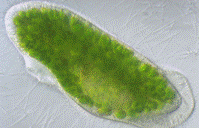Papers in the Biological Sciences
Document Type
Article
Date of this Version
1994
Citation
Plant Physiol. (1994) 106: 1115-1122
Abstract
Plant mitochondria have the unique ability to directly oxidize exogenous NAD(P)H. We recently separated two NAD(P)H dehydrogenase activities from maize (Zea mays 1.) mitochondria using anion-exchange (Mono Q) chromatography. The first peak of activity oxidized only NADH, whereas the second oxidized both NADH and NADPH. In this paper we describe the purification of the first peak of activity to a 32-kD protein. Polyclonal antibodies to the 32-kD protein were used to show that it was present in mitochondria from several plant species. Two-dimensional gel analysis of the 32-kD NADH dehydrogenase indicated that it consisted of two major and one minor isoelectric forms. lmmunoblot analysis of submitochondrial fractions indicated that the 32-kD protein was enriched in the soluble protein fraction after mitochondrial disruption and fractionation; however, some association with the membrane fraction was observed. lhe membraneimpermeable protein cross-linking agent 3,3’-dithiobis- (sulfosuccinimidylpropionate) was used to further investigate the submitochondrial location of the 32-kD NADH dehydrogenase. lhe 32-kD protein was localized to the outer surface of the inner mitochondrial membrane or to the intermembrane space. lhe pH optimum for the enzyme was 7.0. lhe adivity was found to be severely inhibited by p-chloromercuribenzoic acid, mersalyl, and dicumarol, and stimulated somewhat by flavin mononucleotide.


Comments
Copyright American Society of Plant Biologists. Used by permission.